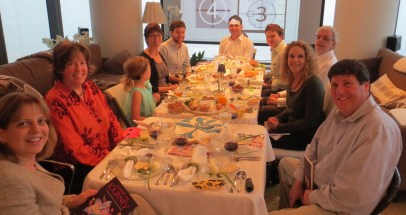For one in six Americans, hunger is a daily reality. That’s right—1 in 6, close to 50 million of our citizens! As you are reading this article, nearly 13 million families in America are struggling with food insecurity. And most of these do not match the stereotype that we too often conjure up in our minds: instead they are normally hardworking families who simply cannot make ends meet and are forced, for lack of sufficient funds, to cut back on the amount of food they eat—sometimes it just the adults, too often the entire family.
In the Torah portion Emor (‘speak’) God commands us (Leviticus 23:22), “And when you reap the harvest of your land, you shall not reap all the way to the edges of your field, or gather the gleanings of your harvest. You shall leave them for the poor and the stranger: I am Adonai Your God.” In parashat K’doshim (Leviticus 19:9) we encounter a similar mitzvah with the additional instruction that “you shall not pick your vineyard bare or gather the fallen fruit of your vineyard.”
Rabbi Bernard Bamberger z”l, broadened our understanding of theses verses in his commentary on the book of Leviticus for The Torah: A Modern Commentary (URJ Press). He refers to “the rights of the poor at harvest time…It confers the right to glean and to harvest the uncut edge on those who have no resources of their own. It is perhaps the oldest declaration that the disadvantaged members of a society have a right to support from the society. They should not be dependent on voluntary benevolence alone…”
Rabbi Bamberger’s multiple use of the word ‘rights’ when it comes to the poor and hungry in our midst represents a radical new use of language that, if adopted, would change our understanding of our society’s obligations to those millions of Americans who are daily challenged to feed themselves at all, let alone nutritiously. Neither our political nor our judicial system has ever spoken of the ‘rights of the poor and hungry’. The adoption of this creative language would be an important first step towards changing the attitudes and practices that conspire to keep hungry Americans in such desperate straits.
I recently accepted an invitation to join the national Board of MAZON: A Jewish Response to Hunger, and I am honored to serve in this position. In recent months I have learned a lot about the issue of food insecurity in America (and in Israel), and I am often horrified that in our day this struggle is still so common. I am proud that many Reform congregations have adopted ‘Hunger’ as the central focus of their social justice efforts. Many synagogues host weekly Soup Kitchens, regularly make sandwiches distributed at multi-service centers and deliver bags of food to the needy multiple times per year. This is wonderful work, God’s work. Nevertheless, these benevolent activities are stopgap measures. The only way to end the devastating problem of hunger is to pursue justice for everyone.
The Union for Reform Judaism, our Religious Action Center, our Reform movement’s Commission on Social Action and the Central Conference of American Rabbis have each adopted resolutions that challenge us to fight the injustice of hunger and food insecurity in our midst. These statements of support go back as far as 1975 and have been reiterated on several occasions through the intervening years. But while they theoretically commit us to engage in this fight, we clearly are not yet doing enough. The statistics are simply overwhelming.
Deuteronomy Chapter 15 challenges us: “If, however, there is a needy person among you, one of your kin in any of your settlements in the land that the Lord your God is giving you, do not harden your heart and shut your hand against your needy kin. Rather, you must open your hand and lend them sufficient for whatever they need….for there will never cease to be poor in the land. Therefore I command you, “You shall open wide your hand to your brother, to the needy and to the poor, in your land.”
 As hunger and poverty continue to flourish in America, and as economic inequality continues to widen, I pray that our Reform movement will ever take to heart the obligations that our Torah enjoins upon us. Let us work for the rights of the hungry in our midst and for a just and compassionate society. Feeding the hungry, clothing the naked and welcoming the stranger…these are the real tests of our commitment to making God’s good world even better.
As hunger and poverty continue to flourish in America, and as economic inequality continues to widen, I pray that our Reform movement will ever take to heart the obligations that our Torah enjoins upon us. Let us work for the rights of the hungry in our midst and for a just and compassionate society. Feeding the hungry, clothing the naked and welcoming the stranger…these are the real tests of our commitment to making God’s good world even better.
Rabbi Jonathan A. Stein serves Temple Shaaray Tefila in NYC. He is the Immediate Past President of the Central Conference of American Rabbis.












